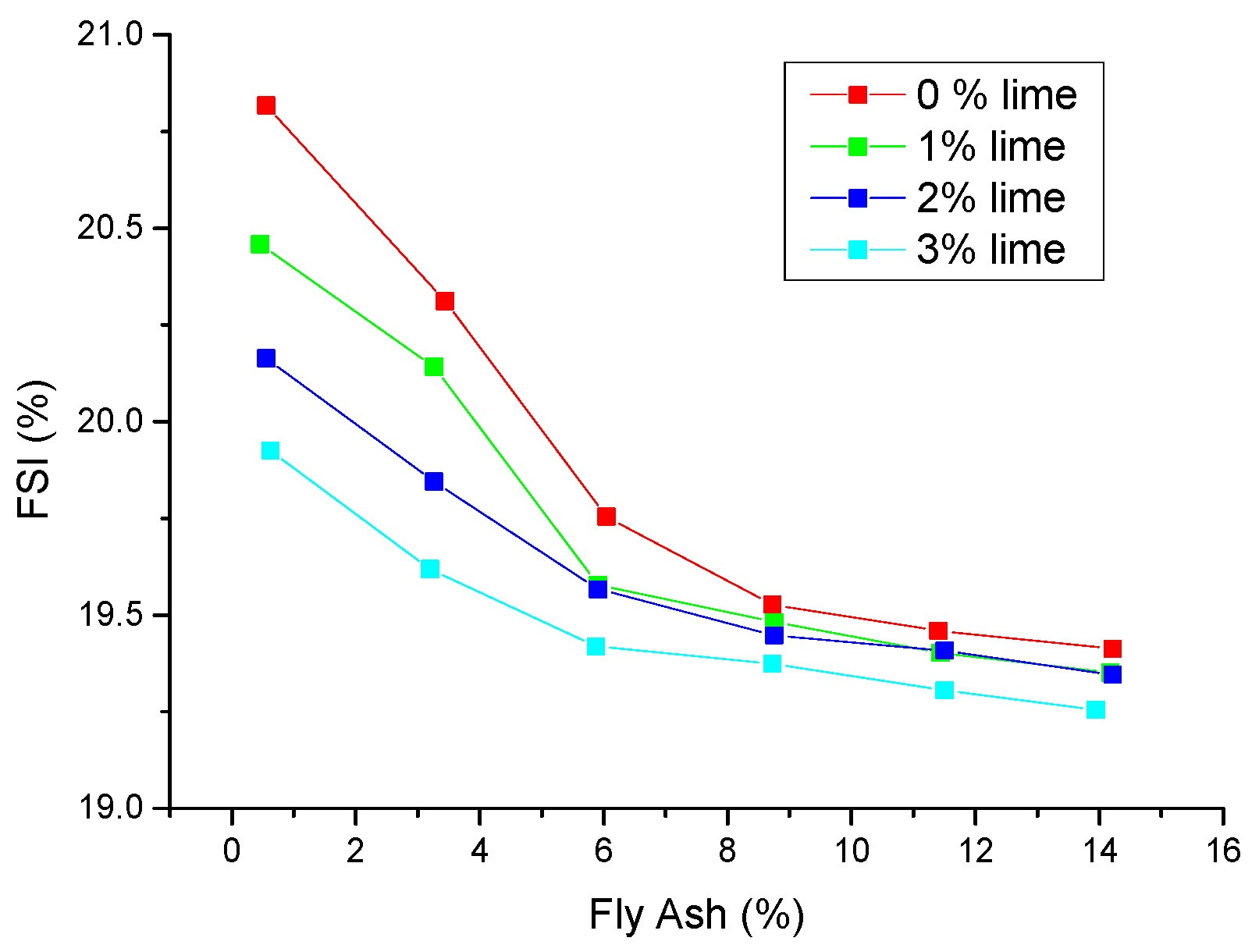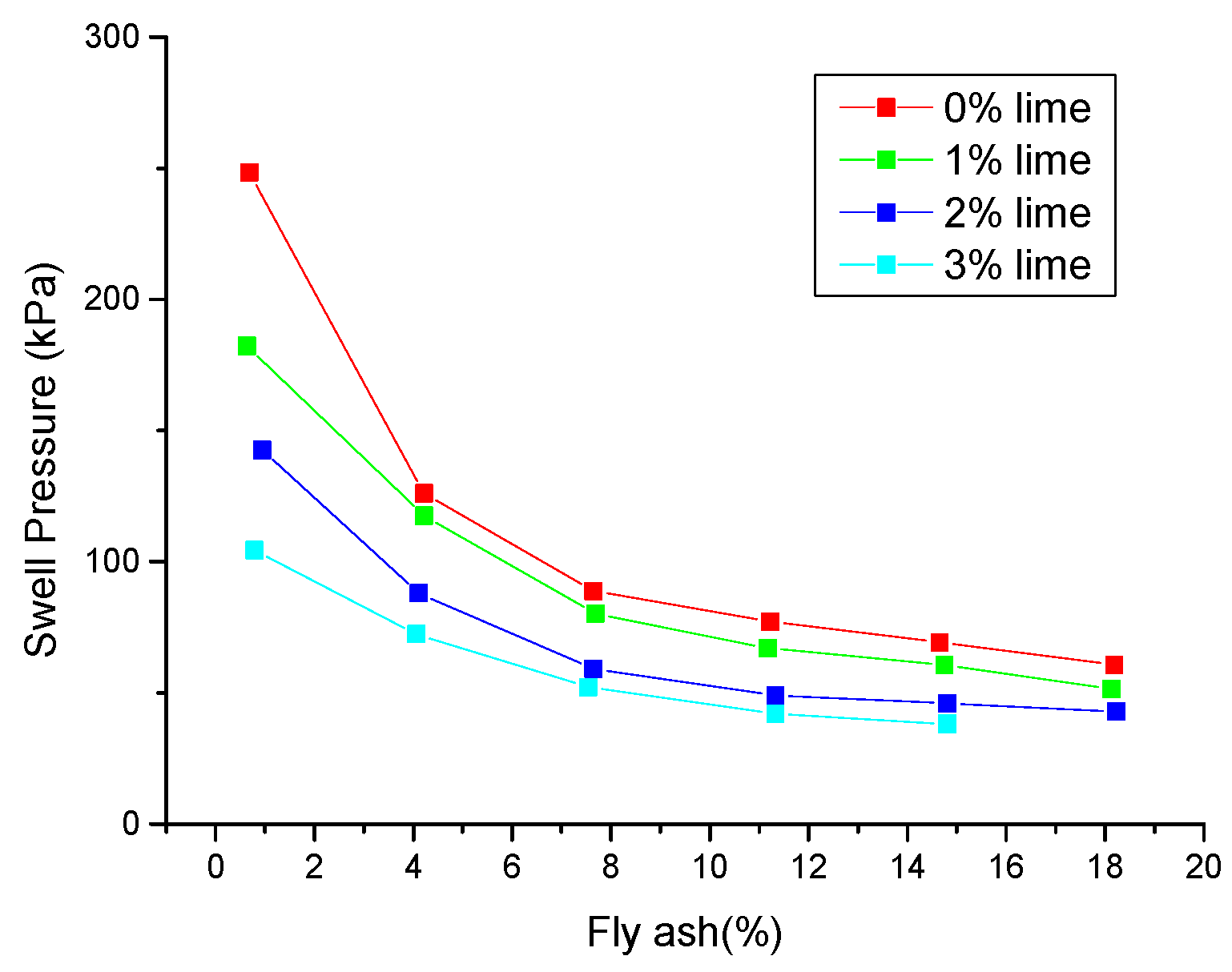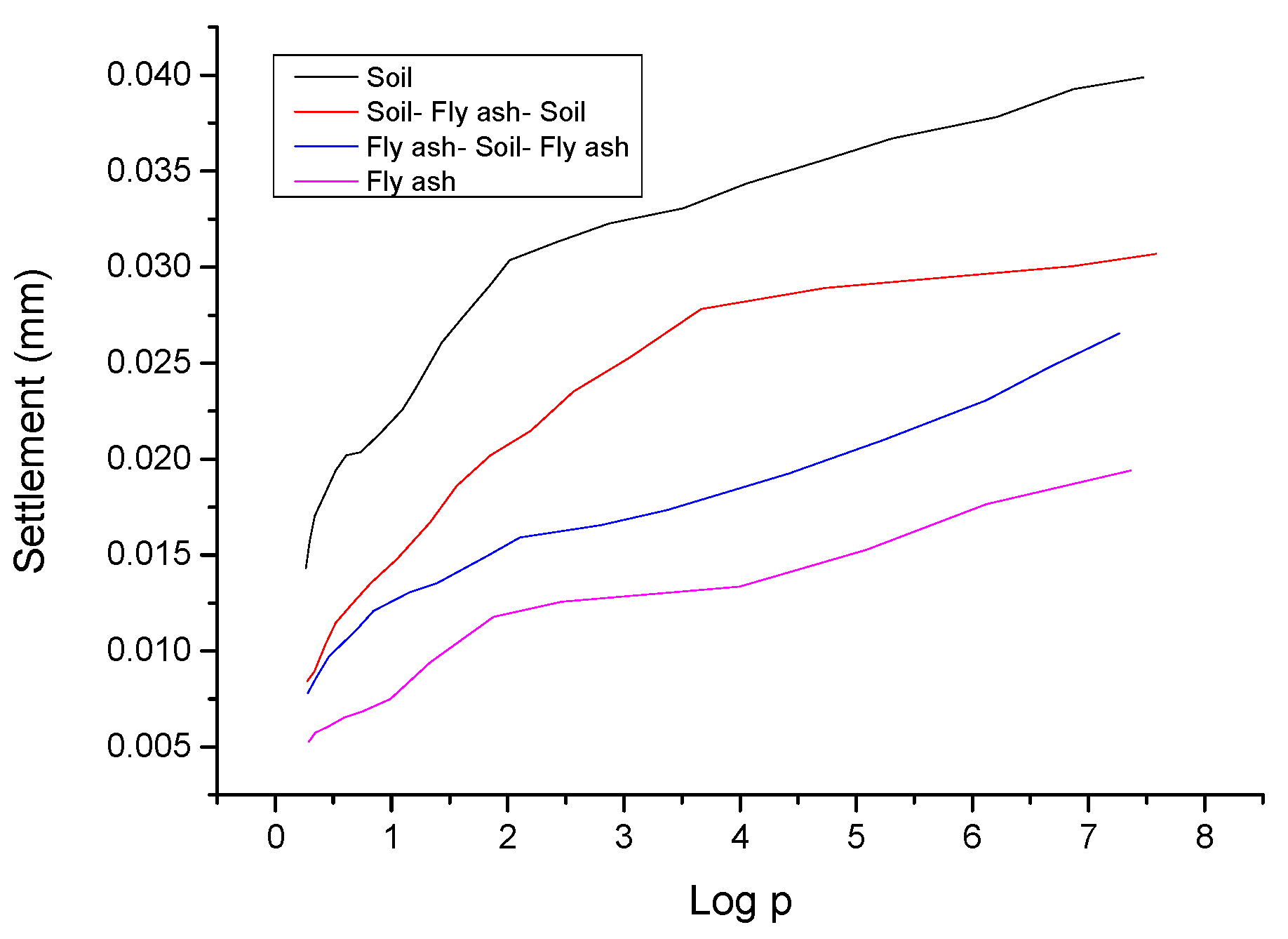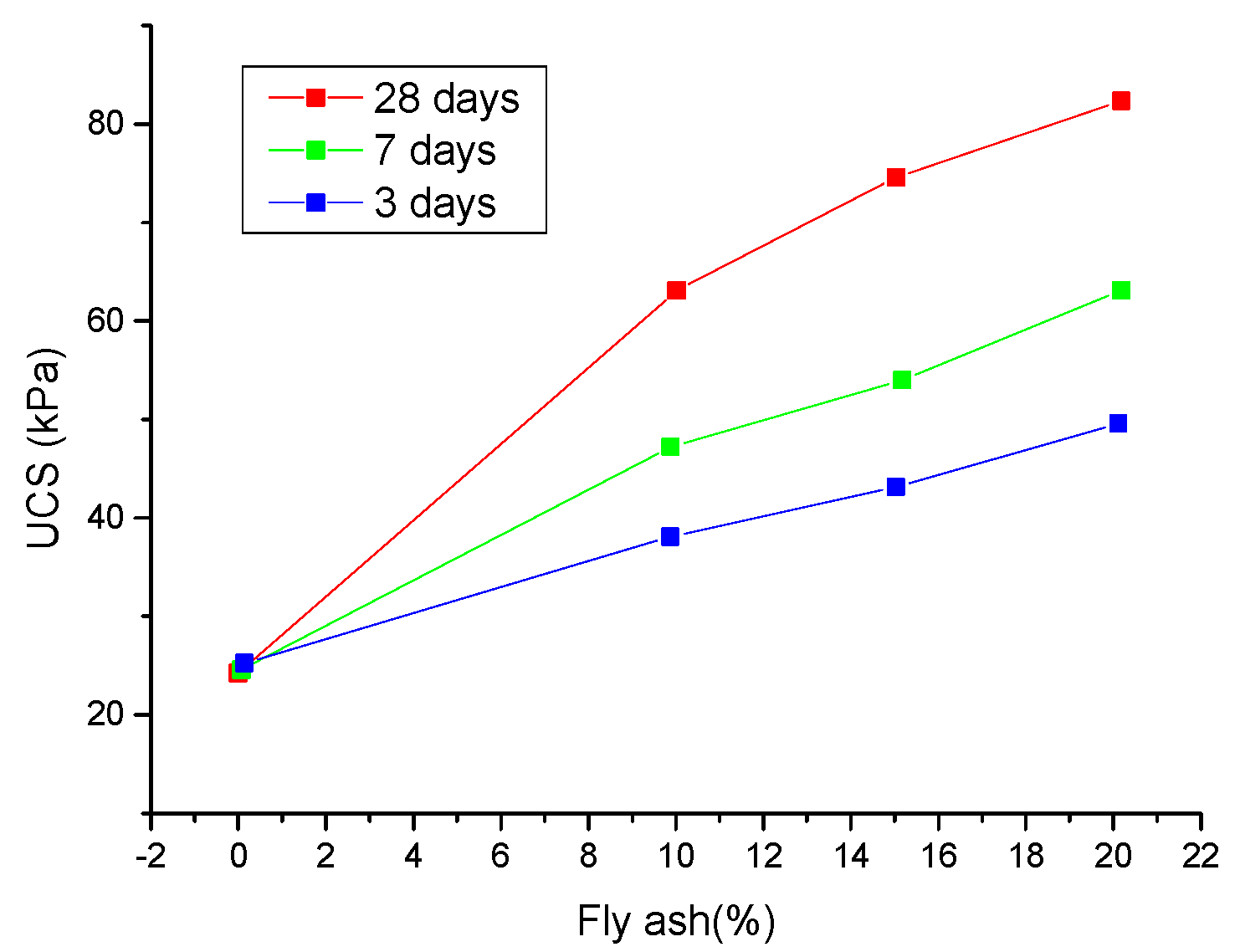Effect of Fly Ash on Geotechnical Properties of Soft Soil: A Critical Review †
Abstract
:1. Introduction
2. Fly Ash and Other Properties
2.1. Fly Ash and Swelling of Soil
2.2. Fly Ash and Soil Settlement
2.3. Fly Ash and Soil Shear Strength
2.4. Fly Ash and California Bearing Ratio Test
3. Future Scope
4. Conclusions
- FA use during clay soil treatment: Waste materials raise the standards for soil consolidation. The compressibility of soil is found to be increased multiple times by the addition of FA, as FA has excellent pozzolanic behaviour.
- The swelling potential and free swelling index decrease with increased fly ash and fine sand content added to clay soil of an expansive nature.
- When blending soil clay with fly ash, secondary consolidation occurs sooner than when the soil clay is not treated. This means that consolidation settling under buildings is reduced and attained in less time in engineering applications.
- The soil treated with fly ash was found to have a CBR value of 10.3% compared to the CBR value of the untreated sample, which was found to be 2.189%. The study suggests combining black cotton soil with fly ash in amounts up to 10% for foundation and pavement work.
Author Contributions
Funding
Institutional Review Board Statement
Informed Consent Statement
Data Availability Statement
Conflicts of Interest
References
- Ravallion, M.; Chen, S.; Sangraula, P. New Evidence on the Urbanization of Global Poverty. Popul. Dev. Rev. 2007, 33, 667–701. [Google Scholar] [CrossRef]
- Faisal Noaman, M.; Khan, M.A.; Ali, K. Effect of artificial and natural fibers on behavior of soil. Mater. Today Proc. 2022, 64, 481–487. [Google Scholar] [CrossRef]
- Srijan; Gupta, A.K. A Review article on Construction, Parametric Study and Settlement Behavior of Stone Column. IOP Conf. Ser. Earth Environ. Sci. 2021, 796, 012021. [Google Scholar] [CrossRef]
- Srijan; Gupta, A.K. Effectiveness of triangular and square pattern of stone column with varying s/d ratio on consolidation behaviour of soil. Second ASCE India Conf. CRISIDE 2020, 1, 1648–1654. [Google Scholar]
- Srijan; Gupta, A.K. The effect of using a sand column on the expansive soil’s swelling characteristics. J. Curr. Res. Eng. Sci. 2022, 5, 1–6. [Google Scholar]
- Hassan, A.; Arif, M.; Shariq, M. Effect of curing condition on the mechanical properties of fly ash-based geopolymer concrete. SN Appl. Sci. 2019, 1, 1694. [Google Scholar] [CrossRef]
- Ozdemir, M.A. Improvement in Bearing Capacity of a Soft Soil by Addition of Fly Ash. Procedia Eng. 2016, 143, 498–505. [Google Scholar] [CrossRef]
- Ram, L.C.; Masto, R.E. Fly ash for soil amelioration: A review on the influence of ash blending with inorganic and organic amendments. Earth Sci. Rev. 2014, 128, 52–74. [Google Scholar] [CrossRef]
- Seco, A.; Ramírez, F.; Miqueleiz, L.; García, B. Stabilization of expansive soils for use in construction. Appl. Clay Sci. 2011, 51, 348–352. [Google Scholar] [CrossRef]
- Kim, B.; Prezzi, M. Evaluation of the mechanical properties of class-F fly ash. Waste Manag. 2008, 28, 649–659. [Google Scholar] [CrossRef]
- Karim, H.H.; Samueel, Z.W.; Jassem, A.H. Behaviour of soft clayey soil improved by fly ash and geogrid under cyclic loading. Civ. Eng. J. 2020, 6, 225–237. [Google Scholar] [CrossRef]
- Tastan, E.O.; Edil, T.B.; Benson, C.H.; Aydilek, A.H. Stabilization of Organic Soils with Fly Ash. J. Geotech. Geoenviron. Eng. 2011, 137, 819–833. [Google Scholar] [CrossRef]
- Rai, P.; Qiu, W.; Pei, H.; Chen, J.; Ai, X.; Liu, Y.; Ahmad, M.; Wu, Y.Z. Effect of Fly Ash and Cement on the Engineering Characteristic of Stabilized Subgrade Soil: An Experimental Study. Geofluids 2021, 2021, 1368194. [Google Scholar] [CrossRef]
- Murmu, A.L.; Patel, A. Studies on the Properties of Fly Ash-Rice Husk Ash-Based Geopolymer for Use in Black Cotton Soils. Int. J. Geosynth. Ground Eng. 2020, 6, 38. [Google Scholar] [CrossRef]
- Salim, N.M. Improvement of the Geotechnical Properties of Expansive Soils Using Fly Ash. J. Southwest Jiaotong Univ. 2021, 56. [Google Scholar] [CrossRef]
- Zha, F.; Liu, S.; Du, Y.; Cui, K. Behavior of expansive soils stabilised with fly ash. Nat. Hazards 2008, 47, 509–523. [Google Scholar] [CrossRef]
- Saha, S.; Pal, S.K. Compressibility behavior of soil and fly ash used in successive layers. Electron. J. Geotech. Eng. 2012, 17, 2659–2670. [Google Scholar]
- Somnath, S. Permeability and Volume Change Behaviour of Soil Stabilised with Fly ash. Int. J. Eng. Res. Technol. 2015, 4, 840–846. [Google Scholar]
- Xu, G.Z.; Qiu, C.C.; Song, M.M.; Cao, Y.P.; Yin, J. Flocculant effects on fluidity and strength behavior of cemented dredged clay with high water content. Mar. Georesour. Geotechnol. 2021, 39, 951–961. [Google Scholar] [CrossRef]
- Yin, J.; Hu, M.M.; Xu, G.Z.; Han, W.X.; Miao, Y.H. Effect of salinity on rheological and strength properties of cement-stabilised clay minerals. Mar. Georesour. Geotechnol. 2020, 38, 611–620. [Google Scholar] [CrossRef]
- Bose, B. Geo-engineering properties of expansive soil stabilised with fly ash. Electron. J. Geotech. Eng. 2012, 17, 1339–1353. [Google Scholar]
- Nath, B.D.; Molla, M.K.A.; Sarkar, G. Study on Strength Behavior of Organic Soil Stabilized with Fly Ash. Int. Sch. Res. Not. 2017, 2017, 1–6. [Google Scholar] [CrossRef] [PubMed]
- Kumar, P.G.; Harika, S. Stabilization of expansive subgrade soil by using fly ash. Mater. Today Proc. 2021, 45, 6558–6562. [Google Scholar] [CrossRef]
- Edil, T.B.; Acosta, H.A.; Benson, C.H. Stabilizing Soft Fine-Grained Soils with Fly Ash. J. Mater. Civ. Eng. 2006, 18, 283–294. [Google Scholar] [CrossRef]






Disclaimer/Publisher’s Note: The statements, opinions and data contained in all publications are solely those of the individual author(s) and contributor(s) and not of MDPI and/or the editor(s). MDPI and/or the editor(s) disclaim responsibility for any injury to people or property resulting from any ideas, methods, instructions or products referred to in the content. |
© 2023 by the authors. Licensee MDPI, Basel, Switzerland. This article is an open access article distributed under the terms and conditions of the Creative Commons Attribution (CC BY) license (https://creativecommons.org/licenses/by/4.0/).
Share and Cite
Srijan; Narula, G.; Sharma, A.; Dogra, V.K. Effect of Fly Ash on Geotechnical Properties of Soft Soil: A Critical Review. Eng. Proc. 2023, 56, 269. https://doi.org/10.3390/ASEC2023-16619
Srijan, Narula G, Sharma A, Dogra VK. Effect of Fly Ash on Geotechnical Properties of Soft Soil: A Critical Review. Engineering Proceedings. 2023; 56(1):269. https://doi.org/10.3390/ASEC2023-16619
Chicago/Turabian StyleSrijan, Gautam Narula, Aditi Sharma, and Vijayinder Kumar Dogra. 2023. "Effect of Fly Ash on Geotechnical Properties of Soft Soil: A Critical Review" Engineering Proceedings 56, no. 1: 269. https://doi.org/10.3390/ASEC2023-16619
APA StyleSrijan, Narula, G., Sharma, A., & Dogra, V. K. (2023). Effect of Fly Ash on Geotechnical Properties of Soft Soil: A Critical Review. Engineering Proceedings, 56(1), 269. https://doi.org/10.3390/ASEC2023-16619






